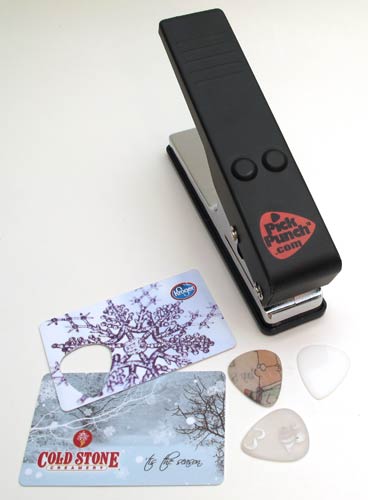Je reprend les quelques renseignements que j'ai mis dans mon test sur cet appareil, et on va essayer d'aprofondir si certains décident de l'acheter.
Donc comme je le disais j'ai découvert, grâce a un ami, un appareil assez original qui permet de fabriquer ses propres médiators.
Cela se présente sous la forme d'une grosse perforeuse:

Il suffit d'utiliser les cartes de crédits périmées, cartes de fidélités dont on nous abreuve a peu pres partout...ou d'acheter des plaques de celluloid, delrin ect... ce qui permet d'avoir la même matière que les médiators Dunlops.
3 modèles différents sont dispo, taille standard, jazz et sweet (triangulaire):

Pour le moment je teste avec des carte SIM, j'attend de recevoir ma machine ces prochains jours pour essayer d'autres types de plastiques.
A vos claviers

Voila ce qui est écris sur le site officiel du Pick Punch concernant les matériaux des médiators que l'on trouve dans le commerce (source wikipedia a prendre avec quelques réserves comme d'habitude):
GENERAL INFORMATION REGARDING ALL PICK MATERIALS:
Most common picks are made out of various types of plastic. Most popular plastics include:
Celluloid. Historically, this was the first plastic ever used to produce picks, and it is still of some use today, especially for guitarists aiming for vintage tone. Occasionally, guitarists who smoke have accidentally discovered the extremely flammable nature of this material.
Nylon. Popular material, has a smooth and slick surface, so most manufacturers add a high-friction coating to nylon picks to make them easier to grip. Nylon is flexible and can be produced in very thin sheets. Most thin and extra-thin picks are made out of nylon. However, nylon loses its flexibility after 1–2 months of extensive use, becomes fragile and breaks, so guitarists that use thin nylon picks should have several spare picks just in case.
Tortex / Delrex. By Jim Dunlop and D'Andrea Picks respectively. Brand names for DuPont Delrin which is specially treated to have a matte, opaque surface, surprisingly easy to grip even with sweaty fingers. Acetal. Acetal is a class of plastics, which is divided into two groups. The copolymer group, was first introduced by McAndrew Hoechst Celanese Corporation in 1960. Steve Clayton uses this branch for their line of Acetal picks. DuPont's (Wilmington, DE) Delrin developed and patented acetal homopolymer. Delrin is a Dupont trade mark/name. Dupont homopolymer acetal, is slightly harder, and stiffer than the copolymer branch. Both acetals have a matte surface for grip, and are highly durable.
Ultem. This space age plastic has the highest stiffness of all plastic picks. Produces a brighter tone. Introduced by Steve Clayton,Inc., the material is additionally popular among mandolin players.
Lexan. Glossy, glass-like, very hard surface, though it wears out relatively fast. Barely bends at all and it's commonly used only for thick and extra-thick picks (> 1 mm). Usually has a high-friction grip coating. Best known example of Lexan picks are Jim Dunlop Stubby series.
Modern plastics can be ranged this way from the easiest to bend to the hardest: Nylon, Acetal, Delrin (Tortex/Delrex), Lexan, Ultem. This means that the same medium (for example, 0.70–0.80 mm) pick would be fairly flexible if made out of nylon and very solid if made out of Ultem.